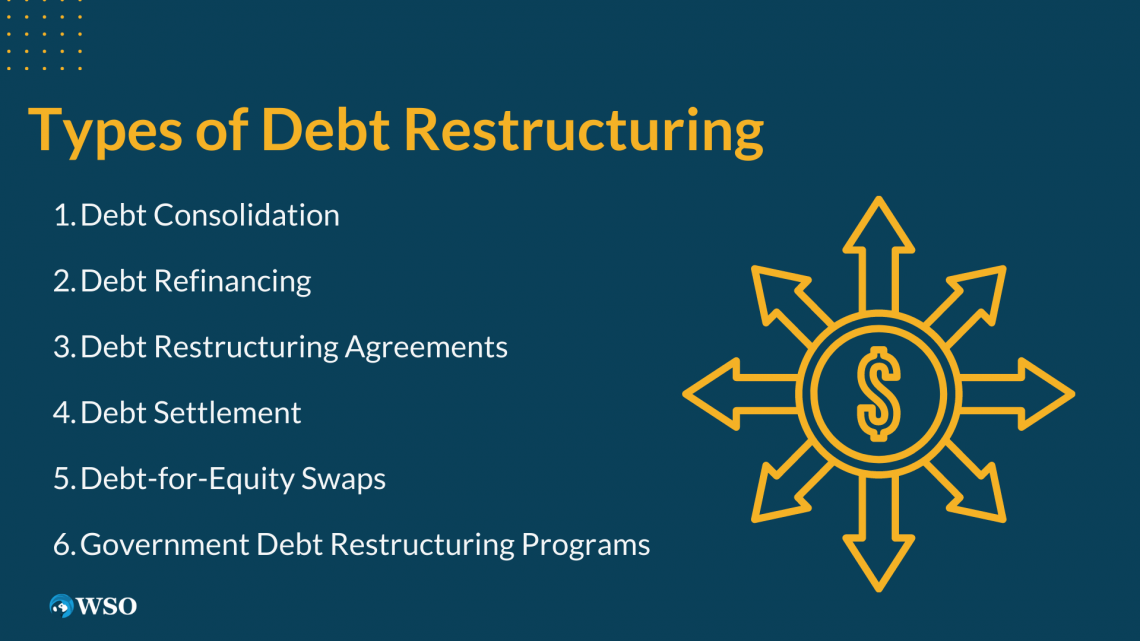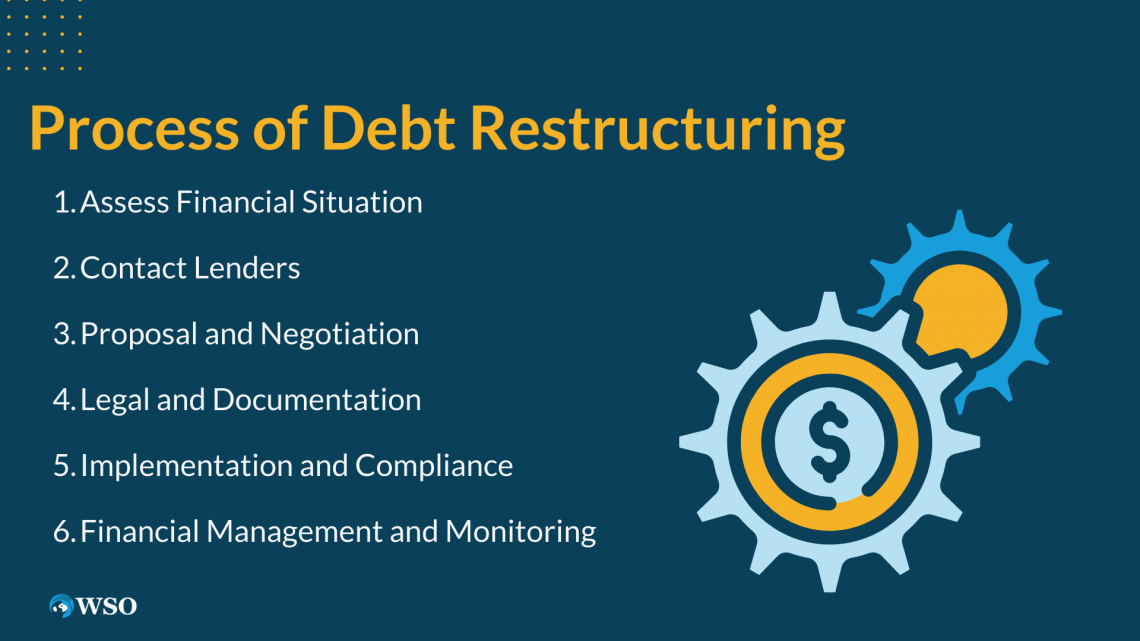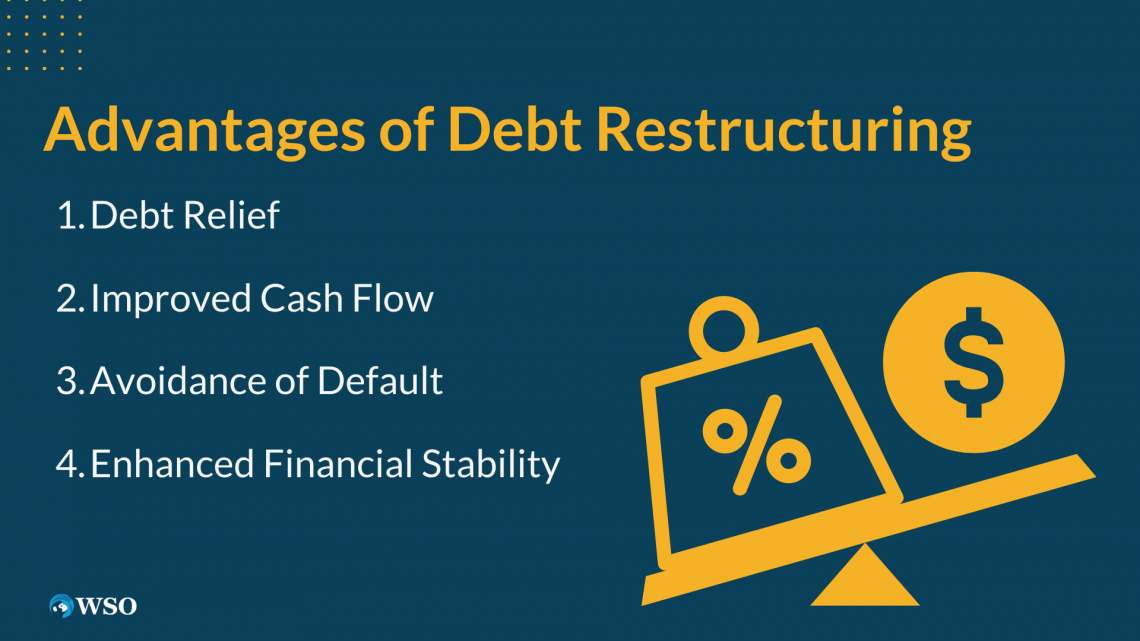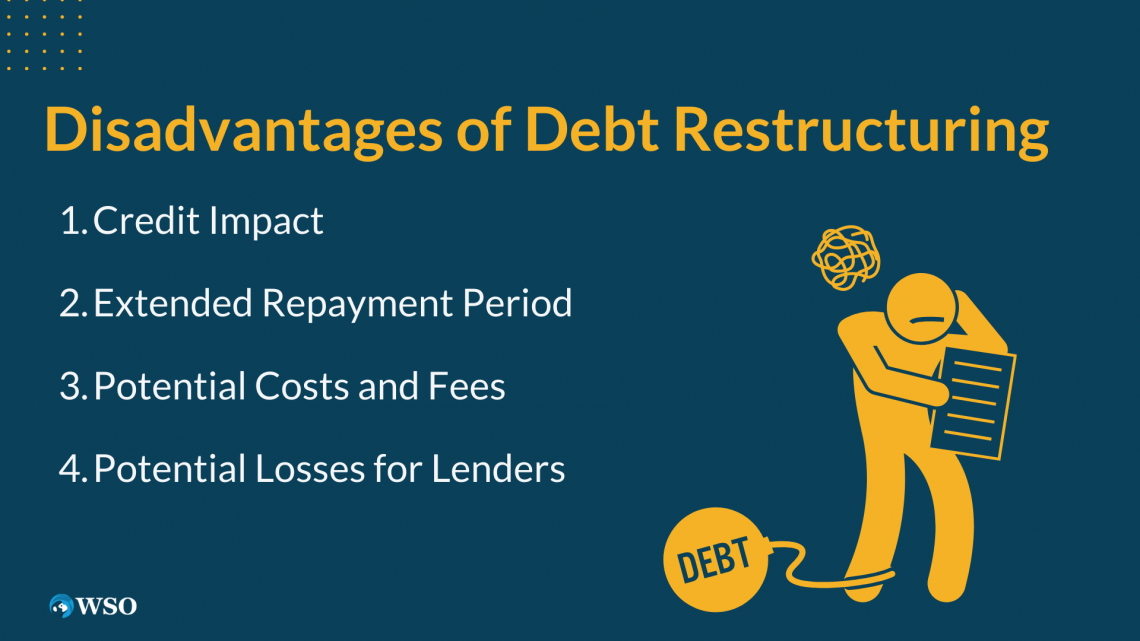Debt Restructuring
It is a financial strategy that individuals, companies, and governments employ to manage and alleviate the burden of outstanding debts.
What is Debt Restructuring?
Debt restructuring is a financial strategy that individuals, companies, and governments employ to manage and alleviate the burden of outstanding debts.

It is a process carried out when borrowers face financial difficulties or cannot meet their debt obligations. It involves modifying the terms and conditions of existing debt obligations to create a more manageable repayment plan.
The debt restructuring concept revolves around revising the debt terms to balance the interests of borrowers and lenders.
It aims to find a mutually beneficial solution that allows borrowers to regain their financial stability while ensuring that lenders recover a substantial portion of the outstanding debt. It may have different forms depending on the specific needs and situations of the debtor.
It may include:
- Increasing the debt repayment period
- Decreasing the interest rate
- Leaving a portion of the principal debt
The purpose of this strategy extends beyond immediate relief. This strategy is typically a collaborative process that requires mutual agreement and understanding between the parties involved.
By restructuring debt, borrowers can avoid the potentially devastating consequences of defaulting on their obligations, such as damaged credit ratings, legal actions, or bankruptcy.

It provides a way for borrowers to take control of their financial situation and work towards an efficient way of debt repayment.
It is not only beneficial for borrowers but also for lenders. By renegotiating the terms of debt, lenders can improve the chances of recovering their funds compared to the alternative of outright default.
It allows them to minimize losses and maintain a working relationship with borrowers who may have faced temporary financial hardships.
Key Takeaways
- Debt restructuring is a financial strategy generally used to manage and remove the burden of outstanding debts by revising the terms and conditions of existing debt obligations.
- This strategy helps maintain a mutual balance between the interests of borrowers and lenders, relieving struggling borrowers while ensuring lenders recover a substantial portion of the debt.
- The debt restructuring process involves assessing the financial situation, contacting lenders, proposing and negotiating new terms, implementing and complying with the revised repayment plan, and actively managing finances.
- This strategy offers benefits such as debt relief, improved cash flow, avoidance of default, etc. However, it can also have drawbacks such as credit impact, extended repayment periods, potential costs and fees, and potential losses for lenders.
Types of Debt Restructuring
Debt restructuring encompasses a range of approaches and techniques that can be employed to modify the terms of existing debt obligations. Each type of strategy aims to address specific financial challenges borrowers face and provide a viable solution for debt management.

Understanding the various approaches can help borrowers and lenders choose the most suitable option for their circumstances. Here, we explore some common types of debt restructuring:
This approach involves combining multiple loans into one loan with an interest rate more favorable to both parties' interest.
By consolidating debts, borrowers can simplify their repayment process and potentially reduce their monthly payments. This is particularly useful when dealing with high-interest credit card debts or multiple loans.
When a borrower switches an existing debt obligation to another debt obligation offering better terms, it is called debt refinancing. It can be done with the same or a different lender.
This typically involves obtaining a new loan with an interest rate lower than the previous interest rate or a shorter debt repayment period.
Note
Refinancing is commonly used to reduce monthly payments or secure a fixed interest rate, providing borrowers with more stability and potentially saving them money over the long term.
3. Debt Restructuring Agreements
Under this type, a borrower agrees with the lender for an existing debt with revised terms and conditions of the debt obligation.
These agreements are typically reached through negotiations between the borrower and the lender. This will emphasize the collaborative nature of this type of debt restructuring.
It may include modifying interest rates, extending the repayment period, or forgiving a portion of the principal debt.
Note
Restructuring agreements are mostly used when borrowers face financial distress or risk defaulting on their debt obligations.
Debt settlement occurs when borrowers negotiate with lenders to settle their debts for a reduced amount. Generally, borrowers make a lump-sum payment or a series of negotiated payments to settle the debt.
Debt settlement is a way for borrowers facing severe financial distress who cannot repay their debts.
5. Debt-for-Equity Swaps
This type of debt restructuring is commonly used in corporate settings. It involves converting a portion of the debt owed by a company into equity or ownership stakes.
Note
By converting debt into equity, companies can reduce their debt burden and allow creditors to become partial owners, potentially benefiting from the company's future success.
6. Government Debt Restructuring Programs
Governments sometimes implement debt restructuring programs to manage their national debts. These programs may involve a combination of strategies, such as extending repayment periods, reducing interest rates, or seeking assistance from international financial institutions.
These programs are typically implemented in response to a country's economic challenges or excessive debt burdens. Government debt restructuring aims to alleviate the burden of excessive debt and restore economic stability.
Note
The suitability and availability of these debt restructuring options may vary depending on factors such as jurisdiction, type of debt, and specific financial circumstances. To determine the most appropriate debt restructuring approach, seek professional advice from financial experts or credit counselors.
The types of debt restructuring mentioned above offer different solutions for borrowers to manage and alleviate the burden of outstanding debts. It is important to seek professional advice from financial experts or credit counselors when considering debt restructuring options.
Whether through consolidation, refinancing, restructuring agreements, settlement, equity swaps, or government programs, the goal is to find a suitable approach that provides relief, improves financial stability, and facilitates a sustainable path toward debt repayment.
Process of Debt Restructuring
Debt restructuring involves several important steps that borrowers and lenders should follow to successfully revise the terms of existing debt obligations.

There are some general guidelines and necessary considerations to keep in mind:
1. Assess Financial Situation
The first step is for borrowers to assess their financial situation thoroughly. This includes evaluating their current debts, cash flow, income, and expenses. Understanding the extent of the financial challenges will help determine the most appropriate debt restructuring approach.
Note
The borrowers should also consider their credit history and credit scores.
2. Contact Lenders
Once the borrowers have clarity of their financial situation, they should contact their lenders to discuss the revision of debt obligation.
Open communication is necessary at this stage, as it allows the borrowers and lenders to explore various solutions and negotiate new terms for debt obligation upon the borrower.
Note
The borrowers may need to provide supporting documentation, such as financial statements or hardship letters, to strengthen their case and demonstrate their need for adopting this strategy.
3. Proposal and Negotiation
Borrowers must present a formal proposal to their lenders outlining the proposed changes to the debt structure.
This may include requests for interest rate reductions, extended repayment periods, or debt forgiveness. Lenders will review the proposal and negotiate acceptable terms to both parties.
4. Legal and Documentation
Once an agreement is reached, it's essential to formalize the new terms through legally binding documentation. This may involve drafting a new loan agreement, modification agreement, or other legal documents.
The new documents must be carefully reviewed, and seek legal advice if needed. This shows the need for borrowers to fully understand the terms and conditions of the revised debt structure.
5. Implementation and Compliance
After the new terms are documented, borrowers must follow the revised repayment schedule and fulfill their obligations as per the agreement.
Note
Timely and consistent payments are critical to the success of the adoption of this strategy.
6. Financial Management and Monitoring
Throughout the restructuring process, borrowers should actively manage their finances and closely monitor their progress. It's important to develop a realistic budget, track expenses, and seek professional advice to ensure long-term financial stability.
Note
Key considerations during the restructuring process include the willingness of lenders to negotiate, the impact on credit scores, tax implications, and potential fees or costs associated with the restructuring.
It's essential to carefully evaluate these factors and understand the potential consequences before proceeding with debt restructuring.
Moreover, seeking professional guidance from financial advisors or credit counselors can provide valuable insights and assistance.
Their experience can help borrowers with complex financial situations, negotiate favorable terms, and ensure compliance with legal and regulatory requirements.
Seeking professional guidance is particularly important for borrowers with complex financial situations or those unfamiliar with the process of debt restructuring.
Debt restructuring may temporarily impact credit scores. Rebuilding credit after restructuring of debt is crucial for restoring a positive credit history and financial well-being.
Advantages of Debt Restructuring
This strategy can offer significant benefits to borrowers facing financial challenges, but assessing the pros and cons is essential.

Here, we explore the pros and cons of this strategy. The merits of Debt Restructuring are:
1. Debt Relief
Restructuring of debt gives the potential for immediate relief from the burden of unmanageable debt. By altering the terms of the debt obligation, the borrowers can
- Get lower interest rates
- Reduced monthly payments
- Extended repayment periods
- Making it easier to meet their financial obligations.
2. Improved Cash Flow
Restructuring of debt can free up cash flow, allowing borrowers to allocate funds toward other important expenses or investments.
Note
Lower monthly payments can provide breathing room and help stabilize personal or business finances.
The negative impact on credit scores is usually temporary and can be gradually improved as borrowers fulfill their new repayment obligations. This will provide reassurance to readers who may be concerned about the credit implications.
3. Avoidance of Default
Restructuring of debt offers an alternative to defaulting on debt obligations, which can have severe consequences such as damaged credit scores, collection actions, and legal proceedings.
By restructuring debt, borrowers can work towards resolving their financial difficulties while maintaining a more positive credit history.
While it may result in higher overall interest payments, it can also provide immediate relief and make monthly payments more manageable.
4. Enhanced Financial Stability
Restructuring of debt offers a way for borrowers to make their financial future more stable. With manageable repayment terms, borrowers can better plan and budget their finances, reducing the risk of future financial hardships.
Disadvantages of Debt Restructuring
Some of the most common disadvantages are:

1. Credit Impact
Restructuring of debt may have a temporary negative impact on credit scores. Creditors can declare the loan settled or restructured, resulting in a lower credit score and making it more difficult to take a loan in the future.
However, their credit scores can gradually improve as borrowers fulfill their new repayment obligations.
2. Extended Repayment Period
While increased repayment periods can provide instant relief, they can also result in higher overall interest payments over the long term.
Borrowers should consider the total cost of restructuring their debts and assess whether the benefits outweigh the extended commitment.
3. Potential Costs and Fees
Restructuring of debt may involve certain costs and fees, such as loan modification fees, legal fees, or penalties for early repayment.
Note
It is crucial to thoroughly understand these costs and factor them into the evaluation of the restructuring process.
During the debt restructuring process, borrowers may encounter costs and fees such as loan modification fees, legal fees, or penalties for early repayment, which should be carefully considered and understood.
4. Potential Losses for Lenders
Restructuring of debt involves negotiations with lenders, and lenders may not agree to all proposed changes. Lenders may only be willing to offer limited concessions, which could result in borrowers still being responsible for a significant portion of the debt.
Lenders may have their own financial constraints and limitations in offering concessions.
Note
It is important to weigh the benefits against the drawbacks and carefully consider individual circumstances before pursuing restructuring of debt. Professional advice from financial advisors or credit counselors can provide valuable insights and help make informed decisions.
Case Studies: Successful Examples of Debt Restructuring in Different Industries
Restructuring of debt has been successfully implemented in various industries, helping organizations navigate financial challenges and regain stability.

Examining case studies of restructuring of debt can provide valuable insights into the strategies and outcomes achieved. Here, we explore a few notable examples:
1. Automotive Industry
General Motors (GM) was witnessing financial difficulties during the 2008-2009 global financial crisis. To avoid bankruptcy,
GM underwent a debt restructuring process that involved negotiations with bondholders, labor unions, and the government.
Through the restructuring, GM reduced its debt burden significantly by converting a portion of the debt into equity and securing financing from the government.
This allowed the company to emerge from bankruptcy and regain profitability, ultimately leading to its successful turnaround.
2. Airline Industry
Scandinavian Airlines (SAS) witnessed financial difficulties due to increased competition, fuel costs, and economic downturns.
In 2012, SAS embarked on a debt restructuring program that included debt-for-equity swaps, cost-cutting measures, and route optimization.
Note
The restructuring reduced the company's debt burden and improved its financial position. As a result, SAS managed to return to profitability and achieve sustainable growth in subsequent years.
3. Retail Industry
J.Crew, a prominent fashion retailer, underwent a debt restructuring in 2017 to address its mounting debt levels and declining sales.
The company negotiated with its creditors to reduce its debt burden by exchanging debt for equity ownership.
Note
The restructuring allowed J.Crew to strengthen its balance sheet, enhance liquidity, and focus on strategic initiatives.
4. Real Estate Industry
After the 2008 real estate crisis, many real estate developers and companies faced significant debt burdens.
One example is Brookfield Property Partners, a global real estate company engaged in restructuring debt efforts during that period. The company renegotiated loan terms, extended maturities, and proactively managed its debt portfolio.
This enabled Brookfield Property Partners to weather the crisis, improve cash flow, and successfully continue its real estate investment and development activities.
Note
These case studies illustrate the effectiveness of this strategy in diverse industries. Successful execution of this strategy often involves a combination of strategies that highlight the importance of proactive financial management, open communication with creditors, and adapting to changing market conditions.
Successful execution of this strategy requires careful analysis, strategic planning, and stakeholder collaboration to achieve sustainable outcomes.
In summary, case studies of debt restructuring in different industries demonstrate the potential for organizations to overcome financial challenges and achieve successful turnarounds.
Researched and Authored by Basil Khalidi | LinkedIn
Free Resources
To continue learning and advancing your career, check out these additional helpful WSO resources:




or Want to Sign up with your social account?